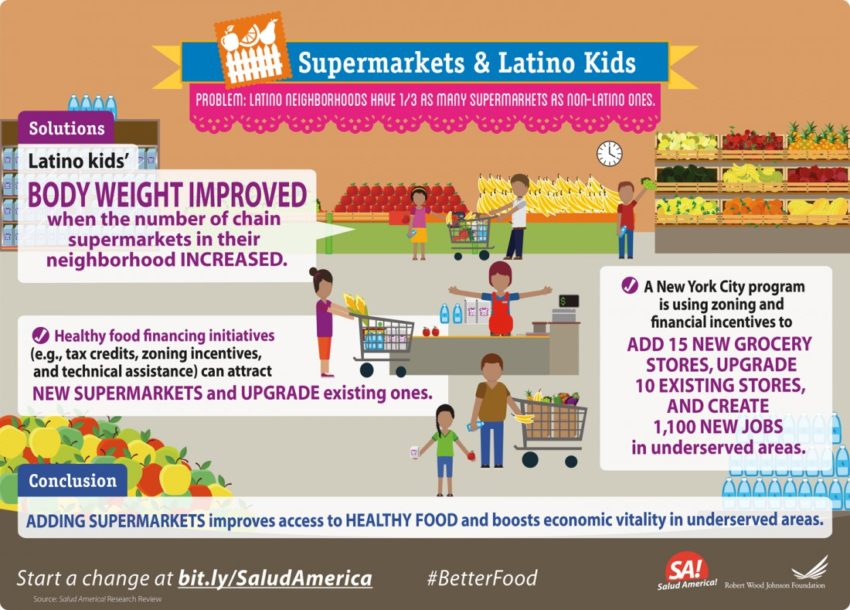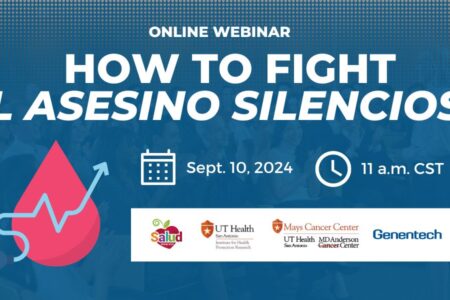
Share On Social!
This is part of our Food and Latino Kids: A Research Review »
More access to supermarkets results in less obesity risk
Greater neighborhood access to supermarkets catering to underserved populations is linked to a lower prevalence of obesity in adults and children.
Evidence from systematic reviews, longitudinal and cross-sectional studies collectively show the relationship between greater access to supermarkets and lower prevalence of obesity.
Only two studies have analyzed the relationship between lack of local supermarket access and obesity over a period of time (2 years and 4 years). The data from these studies show mixed evidence in adults and children.
One study reported that an increase in accessible supermarkets was associated with decreased BMI for adults who moved from rural to urban areas. Additionally, BMI and obesity in adults living in urban areas were positively correlated with neighborhood concentration of small grocery stores, which usually carry a higher proportion of unhealthy foods than supermarkets.17
In a separate study, Shier et al. followed children from fifth to eighth grade and observed that the availability of supermarkets was not associated with a change in BMI in children.18 Neither of these studies was restricted to or performed sub-analyses of underserved populations.
While longitudinal studies are limited in both number and application to underserved communities, several studies have explored the links between obesity and access to supermarkets in underserved populations using cross-sectional analysis, meaning that data from only one point in time is evaluated. While not able to show patterns over time between variables, these studies are able to provide links between access to supermarkets and obesity or diet quality.
Two systematic reviews found that greater accessibility to supermarkets was linked to a lower body mass index (BMI) or prevalence of overweight/obesity.19,20
One of these studies specifically evaluated disadvantaged populations.20 In a study of adolescents, the number of chain supermarkets in Latino neighborhoods was shown to inversely correlate with BMI.21
Another study of predominantly Hispanic and African-American middle and high school students found that proximity to grocery stores near schools offering healthy food options, such as fresh fruits and vegetables and low-fat milk, was linked to a lower BMI score.22
Efforts working to increase supermarkets
Food retail and financing initiatives that introduce supermarkets into underserved communities have the potential to improve access to healthy foods and increase communities’ economic vitality.
The federal government’s national HFFI has been allocating funding to foster the development of new grocery stores in underserved neighborhoods since 2011.
From 2011 through 2014, this federal initiative provided grants to 75 organizations in more than a dozen states carrying out a diversity of food access projects in underserved communities.23
Three of these projects are focused on Latino communities, including the Latino Economic Development Center’s project to develop a cooperative grocery store and two mobile grocery stores that will serve residents in a low-income neighborhood in Minneapolis and a longtime food desert. Each of the stores will contract with immigrant vegetable growers. The project is expected to create 38 new jobs.24
The Hacienda Community Development Corporation was awarded a grant to construct the first Latino public market in Portland, Oregon, which will house 19 businesses, including shops that will specialize in fresh and healthy food. This program is expected to create 47 full-time jobs and to be a new outlet for healthy foods in the midst of a low-income food desert.24
New York City’s FRESH Program provides zoning and financial incentives to property owners, developers and grocery store operators in areas of the city currently underserved by grocery stores and populated with Latino and other ethnic communities. FRESH is expected to help create an estimated 15 new grocery stores and upgrade 10 existing stores, creating 1,100 new jobs.25
The Pennsylvania Fresh Food Financing Initiative (PFFFI) created in 2004 is the nation’s first statewide program to foster the development of supermarkets in underserved communities through grants and loans.
PFFFI provides loans and grants for pre-development, acquisition, equipment, and construction costs for supermarkets locating in underserved areas. It also provides funding for start-up costs, such as employee recruitment and training. Between 2006 and 2010, the program approved funding for 88 projects across the state, creating or retaining more than 5,000 jobs and developing 1.67 million square feet of retail space. These projects are estimated to have improved access to healthy foods for a half million Pennsylvania residents.26
New York, Illinois, Louisiana, California, and other states have instituted healthy food financing initiatives similar to the program in Pennsylvania.
Most of these initiatives are still in the planning or implementation stages, thus their impacts are not yet available in the peer-reviewed literature.14 It is anticipated that these programs will improve access to healthy, affordable foods while stimulating the local economy.
More from our Food and Latino Kids: A Research Review »
- Introduction & Methods
- Key Research Finding: Access to healthy food
- Key Research Finding: Supermarkets (this section)
- Key Research Finding: Farmers Markets
- Key Research Finding: WIC and SNAP
- Key Research Finding: Corner stores
- Key Research Finding: Marketing of unhealthy food
- Policy Implications
- Future Research Needs
References for this section »
(17) Gibson, D. M. The Neighborhood Food Environment and Adult Weight Status: Estimates from Longitudinal Data. Am. J. Public Health 2011, 101 (1), 71–78.
(18) Shier, V.; An, R.; Sturm, R. Is There a Robust Relationship between Neighbourhood Food Environment and Childhood Obesity in the USA? Public Health 2012, 126 (9), 723–730.
(19) Giskes, K.; van Lenthe, F.; Avendano-Pabon, M.; Brug, J. A Systematic Review of Environmental Factors and Obesogenic Dietary Intakes among Adults: Are We Getting Closer to Understanding Obesogenic Environments? Obes. Rev. 2011, 12 (5), e95–e106.
(20) Lovasi, G. S.; Hutson, M. A.; Guerra, M.; Neckerman, K. M. Built Environments and Obesity in Disadvantaged Populations. Epidemiol. Rev. 2009, 31, 7–20.
(21) Powell, L. M.; Auld, M. C.; Chaloupka, F. J.; O’Malley, P. M.; Johnston, L. D. Associations Between Access to Food Stores and Adolescent Body Mass Index. Am. J. Prev. Med. 2007, 33 (4 SUPPL.).
(22) Tang, X.; Ohri-Vachaspati, P.; Abbott, J. K.; Aggarwal, R.; Tulloch, D. L.; Lloyd, K.; Yedidia, M. J. Associations between Food Environment around Schools and Professionally Measured Weight Status for Middle and High School Students. Child. Obes. 2014, 10 (6), 511–517.
(23) Office of Community Services. Healthy Food Financing Initiative.
(24) Office of Community Services. CED Abstracts CED HFFI Grantees FY 2012.
(25) Centers for Disease Control and Prevention. Recommended Community Strategies and Measurements to Prevent Obesity in the United States: Implementation and Measurement Guide.; 2009.
(26) Giang, T.; Karpyn, A.; Laurison, H. B.; Hillier, A.; Perry, R. D. Closing the Grocery Gap in Underserved Communities. J. Public Heal. Manag. Pract. 2008, 14 (3), 272–279.
By The Numbers
1
Supermarket
for every Latino neighborhood, compared to 3 for every non-Latino neighborhood



